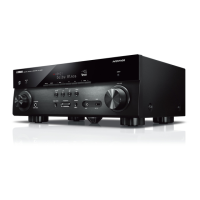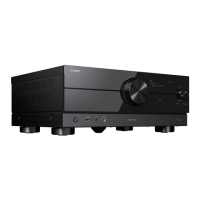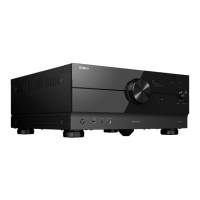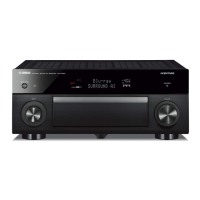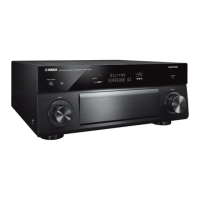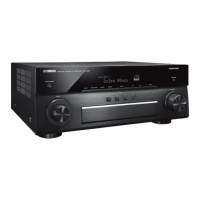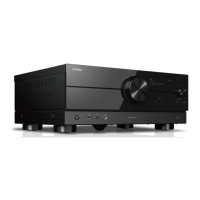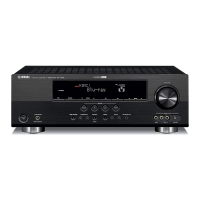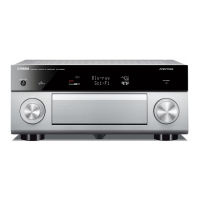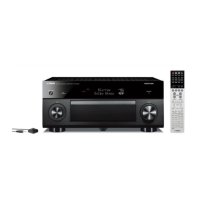Do you have a question about the Yamaha Aventage RX-A6A and is the answer not in the manual?
Explains how to use the user guide and important notes for reading.
Provides explanations of terms and technologies used in the guide.
Lists the accessories that should be supplied with the product.
Covers battery insertion and operating range of the remote control.
Identifies and explains the function of each control and indicator on the front panel.
Explains the various display elements, icons, and status indicators on the front display.
Identifies and explains the function of each connector and terminal on the rear panel.
Details the layout and functions of all buttons on the supplied remote control.
Explains speaker names, functions, and placement for various system configurations.
Details speaker requirements, cable types, and connection procedures.
Guides connecting TV via HDMI for audio/video, using eARC/ARC or optical cable.
Explains wired and wireless network connection methods for the unit.
Covers plugging in the power cable and setting main zone power to on/standby.
Explains how to select sound programs and surround decoders for playback sources.
Leverages AI to create optimal surround effects based on analyzed sound elements.
Utilizes DSP technology to create realistic movie theater or concert hall sound fields.
Covers enjoying original sound (straight decode) and multichannel playback without effects.
Details playback from Bluetooth devices, AirPlay, USB drives, and media servers.
Covers Sleep Timer, SCENE function, and Shortcut function for customized operation.
Explains preparing zones and connecting speakers/HDMI devices for multi-room audio.
Guides on operating Option, Setup, and Front Display menus for comprehensive configuration.
Details sound settings like Lipsync, DSP Parameter, Dynamic Range, and Virtual Speaker options.
Details settings for speaker patterns, system configuration, size, layout, and YPAO.
Basic checks for power, connections, and device status when unit is not functioning.
Addresses power problems like unit not turning on, turning off, or not reacting.
Covers issues like no sound, volume problems, distorted sound, and specific speaker issues.
Covers no video issues from wrong input source, unsupported signals, or connection problems.
Addresses network connectivity, media server access, and Bluetooth connection problems.
Lists common error messages displayed on the front panel and provides remedies.
Provides instructions for cleaning the unit's front panel and general maintenance.
Details methods for connecting to a wireless network via WPS, iPhone, or manual setup.
Lists supported Bluetooth devices, USB devices, and audio/video file formats.
Illustrates video signal flow and provides a video conversion table for HDMI outputs.
Lists product trademarks and compliance statements, including FCC and ISED notices.
Details technical specifications for input/output jacks, HDMI, Bluetooth, Tuner, and USB.
Lists default settings for Option, Setup, and Front Display menus for easy reset.
Explains how to use the user guide and important notes for reading.
Provides explanations of terms and technologies used in the guide.
Lists the accessories that should be supplied with the product.
Covers battery insertion and operating range of the remote control.
Identifies and explains the function of each control and indicator on the front panel.
Explains the various display elements, icons, and status indicators on the front display.
Identifies and explains the function of each connector and terminal on the rear panel.
Details the layout and functions of all buttons on the supplied remote control.
Explains speaker names, functions, and placement for various system configurations.
Details speaker requirements, cable types, and connection procedures.
Guides connecting TV via HDMI for audio/video, using eARC/ARC or optical cable.
Explains wired and wireless network connection methods for the unit.
Covers plugging in the power cable and setting main zone power to on/standby.
Explains how to select sound programs and surround decoders for playback sources.
Leverages AI to create optimal surround effects based on analyzed sound elements.
Utilizes DSP technology to create realistic movie theater or concert hall sound fields.
Covers enjoying original sound (straight decode) and multichannel playback without effects.
Details playback from Bluetooth devices, AirPlay, USB drives, and media servers.
Covers Sleep Timer, SCENE function, and Shortcut function for customized operation.
Explains preparing zones and connecting speakers/HDMI devices for multi-room audio.
Guides on operating Option, Setup, and Front Display menus for comprehensive configuration.
Details sound settings like Lipsync, DSP Parameter, Dynamic Range, and Virtual Speaker options.
Details settings for speaker patterns, system configuration, size, layout, and YPAO.
Basic checks for power, connections, and device status when unit is not functioning.
Addresses power problems like unit not turning on, turning off, or not reacting.
Covers issues like no sound, volume problems, distorted sound, and specific speaker issues.
Covers no video issues from wrong input source, unsupported signals, or connection problems.
Addresses network connectivity, media server access, and Bluetooth connection problems.
Lists common error messages displayed on the front panel and provides remedies.
Provides instructions for cleaning the unit's front panel and general maintenance.
Details methods for connecting to a wireless network via WPS, iPhone, or manual setup.
Lists supported Bluetooth devices, USB devices, and audio/video file formats.
Illustrates video signal flow and provides a video conversion table for HDMI outputs.
Lists product trademarks and compliance statements, including FCC and ISED notices.
Details technical specifications for input/output jacks, HDMI, Bluetooth, Tuner, and USB.
Lists default settings for Option, Setup, and Front Display menus for easy reset.
| Receiver type | Surround |
|---|---|
| Pre-out channels | 11.2 |
| Audio output channels | 9.2 channels |
| Power output per channel (1KHz@8 Ohm) | 185 W |
| Power output per channel (20-20KHz@8 Ohm) | 150 W |
| HDMI in | 7 |
| PC Audio in | Yes |
| Digital audio coaxial in | 2 |
| Digital audio optical in | 3 |
| Component video (YPbPr/YCbCr) in | 1 |
| Display | - |
| HDCP version | 2.3 |
| Apple docking | No |
| Product color | Black |
| Audio decoders | DTS-HD Master Audio, DTS:X, Dolby Atmos, Dolby Digital Plus, Dolby Surround, Dolby TrueHD |
| Power consumption (standby) | 0.4 W |
| Supported radio bands | AM, DAB, FM |
| Audio formats supported | AAC, AIFF, DSD, FLAC, MP3, WMA |
| Connectivity technology | Wired & Wireless |
| Speakers connectivity type | Banana connector |
| Depth | 442 mm |
|---|---|
| Width | 435 mm |
| Height | 191 mm |
| Weight | 20300 g |
